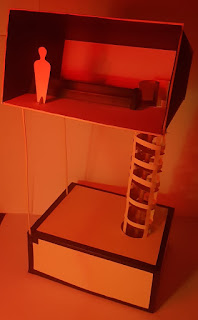WEEK 7 LIGHTING and SCALE + EXPERIMENTATION
THROUGH THE WINDOW MODEL
Experimenting with a single light source helped me create a series of photos which represent what the room looks like at night time .
Through this experimentation i was able to explore the concept of night and day and how you can communicate a certain mood via the lighting you use. This can help the viewer better understand the design aspect of the room by allowing them to experience the room in ways that only someone who lives in the room would.

LIGHTING EXPERIMENTATION
Slanted roof model
GREEN OUTSIDE WINDOWS
The green outside the windows gives the room a nice feeling
The blank room looks clean meaning the cathedral style ceiling and clear story windows stand out as the main features of the room. This plain style helps further communicate these design features as they are the only things that stand out in the pain room.
Through Further experimentation i was able to create different moods and time of day. The human Cutout added scale to the design helping communicate the size.
This room is cosy and the human helped communicate that.
Sunset/sunrise
Nighttime with flash
Street lights
Outside perspective
DREAM Bedroom model
I ran out of rooms and too keep it interesting i decided to build my dream room and wanted it to be on top of a hill and have the most amazing sunsets
The human cutout added scale to the design helping communicate the size and hight of the room.
Here you can see the change in size of human changes the size of the model










